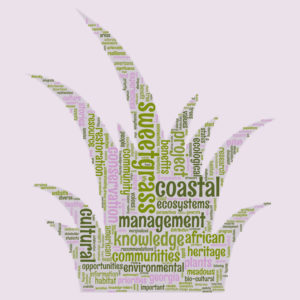
Members of the Direct Descendants of Harris Neck Community and the Sweetgrass Project team, at a workshop to develop the Culturally Important Plant ID Guide.
BIO-CULTURAL CONSERVATION ON THE COAST!
We are starting a new project, funded by NOAA and Georgia Sea Grant, investigating sweetgrass (Muhlenbergia sericea) and other plant species of cultural and ecological importance to Gullah Geechee people and Georgia’s maritime ecosystems. The goal of this project is to understand the status, roles, and significance of sweetgrass and its habitats in Georgia, and to produce actionable knowledge to guide coastal conservation and ecological restoration. The project also entails several other research, outreach, and co-production components to promote education and empowerment opportunities, particularly for coastal African American community members.
PROJECT AIMS:
[A] CONSERVATION AND RESTORATION ECOLOGY:
- Develop a habitat suitability model to determine the range of conditions under which sweetgrass occurs. We can then map coastal areas in Georgia according to high or low suitability for sweetgrass and also identify high priority are
 as for conservation and restoration.
as for conservation and restoration. - Assess population trends by conducting on-the-ground surveys of sweetgrass presence and abundance within as many historic locations and predicted suitable habitat areas as possible. We can then infer population losses, gains, abundance changes, as the nature of the historical data permits.
- Identify conditions associated with sweetgrass meadow resilience. We will monitor responses in sweetgrass populations and the surrounding plant community to the ongoing prescribed burning plan on Little St. Simons Island, to assess resilience to, and recovery from, disturbance, as well as rates of shrub establishment and proliferation.
[B] DIVERSE VALUES AND CONNECTIONS TO PLANTS
- Create a plant identification guide for culturally important plants. This initiative will work with individuals who hold particularly rich ethnobotanical knowledge to clarify the nomenclature and identity of plants traditionally used by coastal African Americans, and compile the information into a visual field guide.
- Conduct the Tree Life Story oral history project. This listening project documents coastal residents’ stories starring a tree, about their connection to a tree, or a memory or event with trees as witnesses. The purpose is to honor and perpetuate the history and lived experiences of coastal African Americans, vis a vis people-plant connections. Stories are digitally recorded and archived in the Library of Congress with consent.
[C] OUTREACH, EDUCATION, AND DECISION SUPPORT
- Georgia Sweetgrass Status Report. The audience for this document includes management agencies, environmental organizations, community organizations, decision-makers, and the general public. Its intended impact is to convey the very real threat of losing much of Georgia’s remaining sweetgrass habitat, and to engender support and action for active management and restoration.
- Habitat Management Report & Recommendations. This document is primarily targeted at coastal land managers, and its goal is to provide technical information and support decisions on appropriate management actions to sustain existing sweetgrass populations.
- Propagation and Restoration Report & Guidelines. The intended audience is not only agencies managing oceanfront shorelines, but also other coastal landowners, landscape professionals, nurseries, and environmental engineering firms, who may consider planting sweetgrass ornamentally, for basketry, as Green Infrastructure in public spaces, and especially as upslope groundcover above living shorelines in marshes.